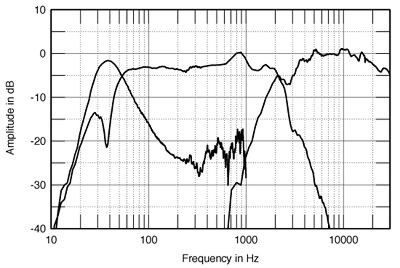| Columns Retired Columns & Blogs |
Merlin Music Systems VSM Millennium loudspeaker system Measurements part 2
The saddle at 37Hz in the fig.5 magnitude plot indicates the tuning of the 2"-diameter port, and there are slight wrinkles in the traces at 250Hz, 400Hz, and 750Hz that might suggest the presence of cabinet resonances of some kind. When I supported the speaker on the supplied carpet-piercing spikes—very sharp—and examined the cabinet vibrational behavior with a simple plastic-tape accelerometer, I was surprised to find nothing untoward at those frequencies. However, I did find resonant modes at 301Hz and 367Hz; these were strongest on the VSM's front baffle, beneath the port (fig.6). I do wonder if these modes contribute to the sense of congestion at very high levels.

Fig.6 Merlin VSM Millennium, cumulative spectral-decay plot of accelerometer output fastened to front baffle beneath port (MLS driving voltage to speaker, 7.55V; measurement bandwidth, 2kHz).
Fig.7 shows the individual responses of the tweeter and woofer on the tweeter axis at 50", spliced below 350Hz to the woofer and port responses measured in the nearfield with the BAM in circuit. The equalizer both boosts the port output and rolls off the woofer and port more rapidly below the port tuning frequency. The woofer is basically flat through most of the midrange but features a small peak between 800Hz and 900Hz before rolling off above 2kHz with a steep slope. Although the tweeter is fundamentally flat in its passband, it looks as though it is balanced a couple of dB high in absolute level.

Fig.7 Merlin VSM Millennium with BAM in circuit, acoustic crossover on tweeter axis at 50", corrected for microphone response, with the nearfield woofer and port responses plotted below 350Hz and 1kHz, respectively.
When these outputs are combined on the tweeter axis, there is a lack of energy in the crossover region (not shown). Fortunately, Merlin Music Systems' Bobby Palkovic had e-mailed me before I measured the speaker to explain that the VSM is intended to be listened to below the tweeter axis, with the listener's ears level with the point where the top of the woofer basket touches the bottom of the tweeter mounting plate. (With the speakers on its spikes, this is exactly 36" from the floor, which we have found to be the average height of a seated listener's ears.) Fig.8 shows the overall response averaged across a 30 degrees horizontal window on this axis, spliced to the complex sum (taking phase into account) of the nearfield woofer and port responses.

Fig.8 Merlin VSM Millennium, anechoic response on design axis at 50", averaged across 30 degrees horizontal window and corrected for microphone response, with the complex sum of the nearfield woofer and port responses plotted below 300Hz, with BAM (top trace) and without (bottom).
The top trace below 300Hz in this graph is with the BAM supplying its 5dB boost at 32dB; the bottom trace is the complex sum of the woofer and port outputs without the equalizer. As the nearfield measurement assumes a 2pi environment for the drive-units, a truly flat speaker will appear to have a moderate 3dB boost in the bass. As the VSM with BAM has just such a small boost, it looks as though the equalized speaker's bass is therefore critically aligned. The BAM extends the measured -6dB point from 37Hz to 29Hz, but the speaker's port is having to move a lot of air to achieve this performance. When I auditioned the speakers at Mikey's, I was astonished to feel puffs of air hitting my hand more than 8' from the speakers on high-level kick drum!
A small point: Remember the slight wrinkle in the impedance traces at 250Hz? There is a slight discontinuity in the Merlin's nearfield output at exactly 250Hz. An airspace problem? An anti-resonance? Whatever this wrinkle is due to, I doubt very much that it will have any audible consequences.
Higher in frequency, the VSM's response appears to gently slope up through the midrange to the very slight peak between 800Hz and 900Hz noted before, though the treble balance is basically even. As MF noted, the speaker has a "smooth, airy, graceful top end, delicate yet detailed," which is what I would have expected from this graph and what I indeed heard for myself. The downside is that the speaker becomes very fussy about the quality of source and amplification components.
With its narrow baffle, the VSM has a wide and even horizontal dispersion (fig.9, actual responses; fig.10, differences in response). This always correlates with excellent imaging precision and stability. These plots were taken on the tweeter axis; note the on-axis depression at 2.8kHz, which actually fills in to the speaker's sides. The optimal listening axis is actually 10 degrees to the side, by the way. And, as Mikey suggested, the 1" soft-dome tweeter does start to get directional in the top audio octave.

Fig.9 Merlin VSM Millennium, lateral response family at 50", from back to front: responses 90 degrees-5 degrees off-axis, on-axis response, responses 5 degrees-90 degrees off-axis.

Fig.10 Merlin VSM Millennium, lateral response family at 50", from back to front: differences in response 90 degrees-5 degrees off-axis, reference response, differences in response 5 degrees-90 degrees off-axis.
- Log in or register to post comments




































